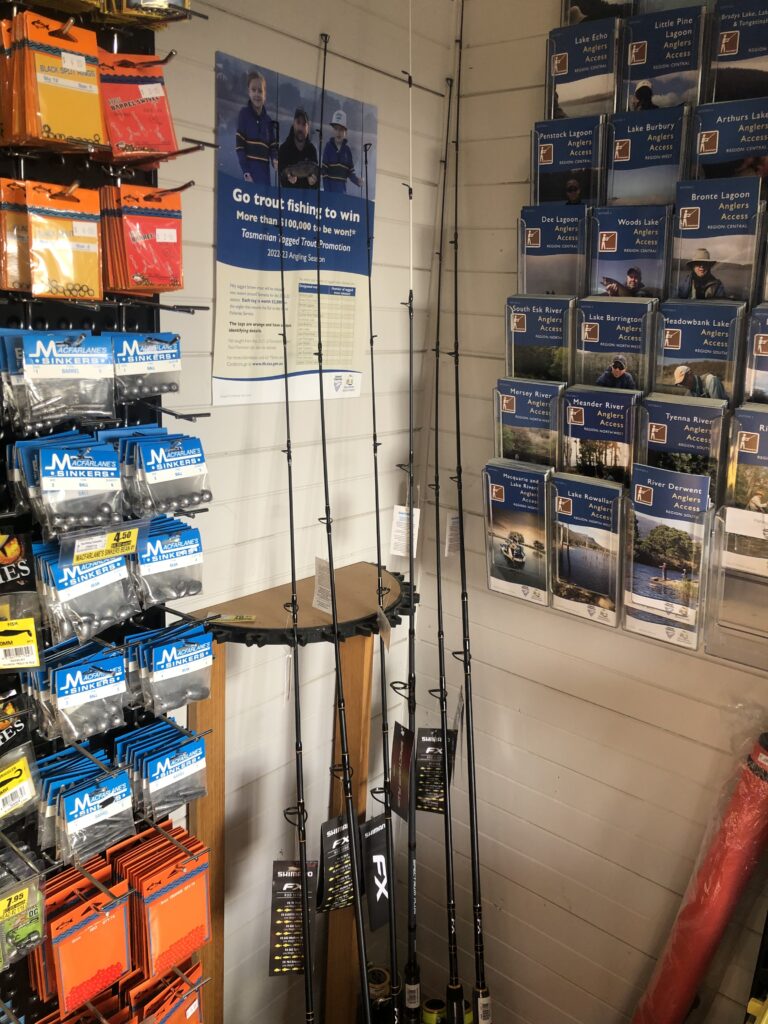Exploring Tasmania’s Love Affair With Fishing

Happy Valentine’s Day! Editor Chris Cocoles was lucky enough to spend 10 days in Australia last month – Melbourne, in the state of Victoria, and the island state of Tasmania – and he got to check out some of the latter state’s love of fishing. This appears in our February issue:
MIENA, Tasmania, Australia– When family members and I planned a rather quick nine-day trip to Australia – four nights in Melbourne, Victoria, five more in the island state of Tasmania – I knew a fishing opportunity might not be easy to plan out. Guides in Tasmania – a known trout fishing destination – are extremely expensive to book, and my budget was already going to be stretched in a country known for high costs for just about everything.
I also considered trying to rent some gear to try my luck DIY style, but that was iffy from the start in a region dotted with mostly small, blink-and-you’ll-miss-it communities save for the capital of Hobart and some other medium-size cities.
So, long story short, with plenty of other items on our to-do list and despite a feeling of FOMO to wet a line, I decided to try and soak in the fishing culture the best I could. Our hectic time in Melbourne featured tennis (Australian Open tickets), wine, whiskey, beer and chocolate tasting, and a road trip on the breathtaking Great Ocean Road west of the city, but I guessed right that Tasmania would be far more pastoral and laid back. (I can report that after getting close to them in two different wildlife sanctuaries, Tasmanian devils are nothing like the over-caffeinated, high-energy Looney Tunes character.) Indeed, I loved the relative peaceful vibe there after the chaos of the crowds at the tennis venue and the urban sprawl of Melbourne.


By the time we checked out of our first hotel and headed north toward “Tassie’s” Central Highlands area, I was excited to at least get a taste of this renowned fishing culture. The night before, at a family-style dinner our hotel sponsored (my smoked duck main course was delectable), we struck up a conversation with a local college professor named Seamus, who had been leading a tour group of history buffs exploring Tasmania’s history of housing prisoners from the British Empire and the Australian continent. As it turns out, Seamus was also a regular fly angler at the Central Highlands lakes that dot the region. He said many of the waters have fish shacks that locals flock to in search of rainbows, brownies and brookies, plus introduced Atlantic salmon.
We headed up the two-lane highway – my brother-in-law Alan took a little time to get used to driving our rental car on the left side of the roads but was a quick learner – passing by plenty of sheep farms and, sadly, more than a few kangaroo and wallaby roadkill victims (the kangaroos we did get to meet and feed at the wildlife sanctuaries were adorable and friendly).


The Great Lake General Store is the heart and soul of Miena (population 87) and has a nice selection of tackle. But there didn’t seem to be much fishing action at adjacent Great Lake on this January morning. (CHRIS COCOLES)
Climbing up to around 3,400 feet, we reached Miena (population 87), where we could see Great Lake, Australia’s second largest lake. My expectation was to see an armada of boats on the water and the
shoreline dotted with bank anglers hoping to entice a trout bite. But Great Lake was anything but from a fishing perspective. No boats, no bank casters and none of the fish shacks Seamus had mentioned.
We pulled up to Miena’s Great Lake General Store – it was about the only one of a handful of businesses open that morning – and briefly chatted with the lady who worked there. She said some of the more remote lakes had some fish shacks and that there would be people out fishing that day. I made a last-ditch effort to see if there was a rental rod and reel available, but she said that wasn’t really possible anywhere in the region. But she did give us a tip to head a few miles north on the winding road to an overlook of some of the lakes and a boardwalk we could take down to Pine Lake for a closer look.


My sister Charlene and I took the 15-minute walk down the twisting boardwalk while the wind chilled us to the bone. Finally, we saw our first evidence of an angler, this one on the shores of tiny Pine Lake. He was far more bundled up for the conditions than I was in my light REI rain jacket and shorts, but when we asked if he’d had any luck, he said he hadn’t started casting his fly rod.
“The fish start getting active between 11 a.m and 1 p.m.,” he said.

We saw plenty of Tasmanian devils at two wildlife sanctuaries, including this character at what’s called the UnZoo. It allows the animals there to live mostly without cages, so they can venture out into the wild if they choose to. (CHARLENE KING)
I didn’t dare ask him why he was there a couple hours early, but even in the morning cold, there were worse places to be than this particular spot with no one else around. Tasmania can make you feel like you’re alone and sharing the land with the trout, the kangaroos, wombats and, of course, the Tassie devils. –Chris Cocoles



